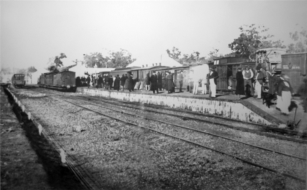There has been lots of confusion when it comes to this settlement. When it was part of the Junee pastoral run, the valley containing the creek which runs from the southeast past Wright’s Oval and through the current wetlands was known as Butler’s Gully. The valley containing the creek which runs from the east past the cemetery and Ricky Hill, and through Pig Gully was known as rock Creek. Both names survive on watershed maps.
The first small settlement on the western side was called Crawley’s Town. After 1881 when George Dobbyns established his subdivision on the area bounded by Hill, Edgar, Church and Short Streets, it became known as Dobbyn’s Town. Once the Government had got its act together after August 1878, the official village was named Loftus after the current governor. This is now the centre of Junee.


The first railway station was called Junee Station, as it was to serve the original town of Junee, 5 miles to the west. In 1879 the fi rst post office was opened and called the Junee Railway Station Post Office. In 1881, after the opening of the rail line to Narrandera and Hay, the name of the railway station changed to Junee Junction, as did the name of the post office.
By 1884, the population had grown to over 1100 and confusion and annoyance among the residents of both the original Junee and Loftus, which was rarely called such, had also grown. In 1885, after a petition from local residents was received by the Government, the town, on 13 October, became officially known as Junee, and the original town became Old Junee. You would think that all would be clear from now on, but no, the railway continued to be called Junee Junction until well into the second half of the 20th century, and the post office did not change its name until 1893.
Take a journey back in the colourful history of historic Junee by taking Junee’s West Side & East Side Self-Guided Tours. The Westside story is a tale of two very different men and two fortunes.

When the Great Southern Railway was built from Sydney to Albury, only one town was newly built on a greenfields site; the town was Junee. When the railway reached the site of Junee on 6th July, 1878, an informal settlement had already formed. In ...

The Westside story is a tale of two very different men and two fortunes. In 1876 Christopher Crawley selected land on both sides of the new railway line, the western part directly in front of the new Railway Station. In 1878 he opened his Railway...